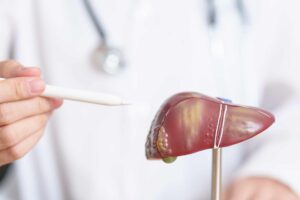What is already known
Candida vaginitis is one of the most common vulvovaginal infections in the world and is caused by the overgrowth of the fungus Candida albicans. Since antifungal medications have limited efficacy and can alter the community of microbes that inhabit the vagina, probiotics containing Lactobacillus — a microbe commonly found in the vaginal microbiota — have been proposed as an alternative treatment. However, probiotics have not yet proved successful in treating and reducing the recurrence of Candida infections.
What this research adds
Researchers have developed a hydrogel that combines Lactobacillus probiotics with nanomaterials called nanozymes, which produce molecules lethal to C. albicans. The hydrogel was more successful than standard antifungal medications in treating Candida vaginitis in mice. It also helped to prevent the recurrence of yeast infection by lowering the vaginal pH and supporting a healthy microbiota.
Conclusions
The findings suggest that combining Lactobacillus probiotics with nanozymes can help treat Candida vaginitis and help the growth of beneficial vaginal microbes.
About 75% of women worldwide suffer from Candida vaginitis, an infection of the vagina caused by an overgrowth of the fungus Candida albicans. Now, researchers have developed a hydrogel that can help combat these infections as well as their recurrence, which occurs in 5 to 8% of women.
The findings, published in Science Advances, suggest that the new approach can also help to regulate the vaginal microenvironment. “Compared with clinical drugs, our system is much friendlier to the vagina,” the authors say.
The current treatment for Candida vaginitis is based on antifungal medications, which, however, have limited efficacy and can alter the community of microbes that inhabit the vagina.
Probiotics containing Lactobacillus, a microbe commonly found in the vaginal microbiota, have been proposed as an alternative therapeutic approach, but they have not yet proved successful in treating and reducing the recurrence of Candida infections.
Previous studies have shown that nanozymes — nanomaterials with enzyme-like properties — can produce toxic molecules that target several pathogens, so researchers led by Hui Wei at Nanjing University set out to explore whether combining Lactobacillus probiotics with nanozymes could help treat Candida vaginitis and prevent its recurrence in mice.
Killing yeasts
The researchers developed peroxidase-like nanozymes, which convert oxygen peroxide into a reactive oxygen species that is lethal to C. albicans. Then, they combined these nanozymes with Lactobacillus probiotics.
The combination with Lactobacillus probiotics boosted the nanozymes’s antifungal activity, the researchers found. The probiotics also helped to reduce the pH of a growth medium when tested on Candida yeasts grown in a dish. “These results indicated that Lactobacillus can produce [oxygen peroxide] and lower the pH of [the growth] medium, the two key requirements to achieve effective probiotic therapy of Candida vaginitis,” the authors say.
Finally, the researchers encapsulated the nanozymes and Lactobacillus probiotics in a hyaluronic-acid hydrogel preparation. When applied into the vagina, enzymes secreted by C. albicans and vaginal bacteria degrade the hyaluronic acid, thus locally releasing the nanozymes-probiotics combination.
Treating infection
Next, the team assessed the efficacy of the hydrogel preparation in mice with Candida vaginitis.
The hydrogel was more successful than Clotrimazole, a standard antifungal medication, in treating Candida vaginitis. It also helped to prevent the recurrence of yeast infection by lowering the vaginal pH and supporting a healthy microbiota, the researchers found.
The hydrogel-based treatment appeared to support a healthier vaginal microbiota by reducing the abundance of Proteobacteria and increasing the levels of Firmicutes. The abundance of Lactobacillus, which can protect the vagina from the colonization and growth of harmful microbes, also increased.
The newly developed approach, the authors say, “could increase the richness and diversity of the vaginal microbiome, especially Lactobacillus, to efficiently treat Candida vaginitis and reduce the recurrence, demonstrating the promise to treat and prevent vaginal dysbiosis.”
However, they add, because the vaginal microenvironment and microbiota of mice are different from those of women, more work is needed to assess the relationship between rodent models and human disease.











